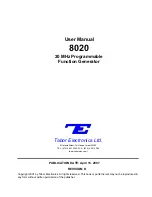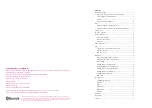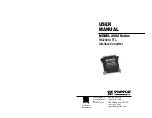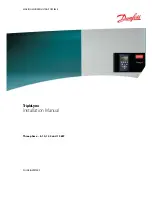
MULTITASKER
400-0394-007
16
34.
[SID+]
This command sets the ID of all the cards in a
system to their slot number plus the offset value.
Command Format: [SID+n]
n
= Offset amount (n = # from 0 to 99)
The maximum card ID is 99, so subtract
the highest slot number from 99 to find
the maximum offset. For example, in an
8-slot enclosure, the maximum offset
would be 91. The slot number (8) plus the
offset (91) equals 99.
Example:
There are two 20-slot enclosures to be
connected together during normal operation.
The first unit will use the default IDs where the
card ID is equal to the slot number. The second
unit will have the same unit ID, but each card ID
will be offset by 20.
Connect the computer to the second unit only
and send [SID+20] to set the ID of all the cards
in the second enclosure to their slot number plus
20. Reconnect both units to the computer.
The cards in the first unit will be referenced as
card IDs 1-20 and the cards in the second unit
will be referenced by card IDs 21-40.
35.
[RSN]
This command displays the slot number of a
card with a specified ID number. If more than
one card has the same ID, each slot number will
be displayed.
Command Format: [RSNCi]
Ci
= Card ID (i = # from 1 to 99)
Example:
The card in slot 4 takes up four slots in the
enclosure. Its ID was set to 1 since it is the first
card installed in the system, reading from left to
right. Send the command [RSNC1] to find the
slot number of this card. The system responds
with the following feedback:
[4]
GROUP COMMANDS
Group commands allow several cards with the
same functions to be controlled simultaneously
with a single command. Up to 8 groups (G1-G8)
may be defined. These commands apply to all
cards, not only the
MT106-103.
36.
[WR]
This command adds cards to a group. In
MultiTasker systems with audio and video cards,
the groups are typically as follows:
Group 1 = Video Cards
Group 2 = Audio Cards
Group 3 = Video and Audio Cards
Command Format: [WRCn
1
Cn
2
…Gk]
Cn = Card ID (n = slot # from 1 to max slots)
Gk = Group ID (k = # from 1-8)
Example:
Add C2, C4, and C6 to G5 by sending the
command [WRC2C4C6G5]. After executing this
command, G5 will consist of C2, C4, and C6.
Now add C8 to G5 by sending [WRC8G5]. C8 is
added to G5, and G5 is not overwritten. View
the contents of G5 by sending [RDG5] and
receiving the following feedback:
[G5=C2C4C6C8]
37.
[RMC]
This command removes one or more cards from
a group.
Command Format: [RMCn
1
Cn
2
…Gk]
Cn = Card ID (n= # from 1 to max slots)
Gk = Group ID (k = # from 1-8)
Example:
G5 consists of the C2, C4, C6, and C8. Remove
C6 and C8 by sending [RMC6C8G5]. View the
contents of G5 by sending [RDG5] and receiving
the following feedback:
[G5=C2C4]






































